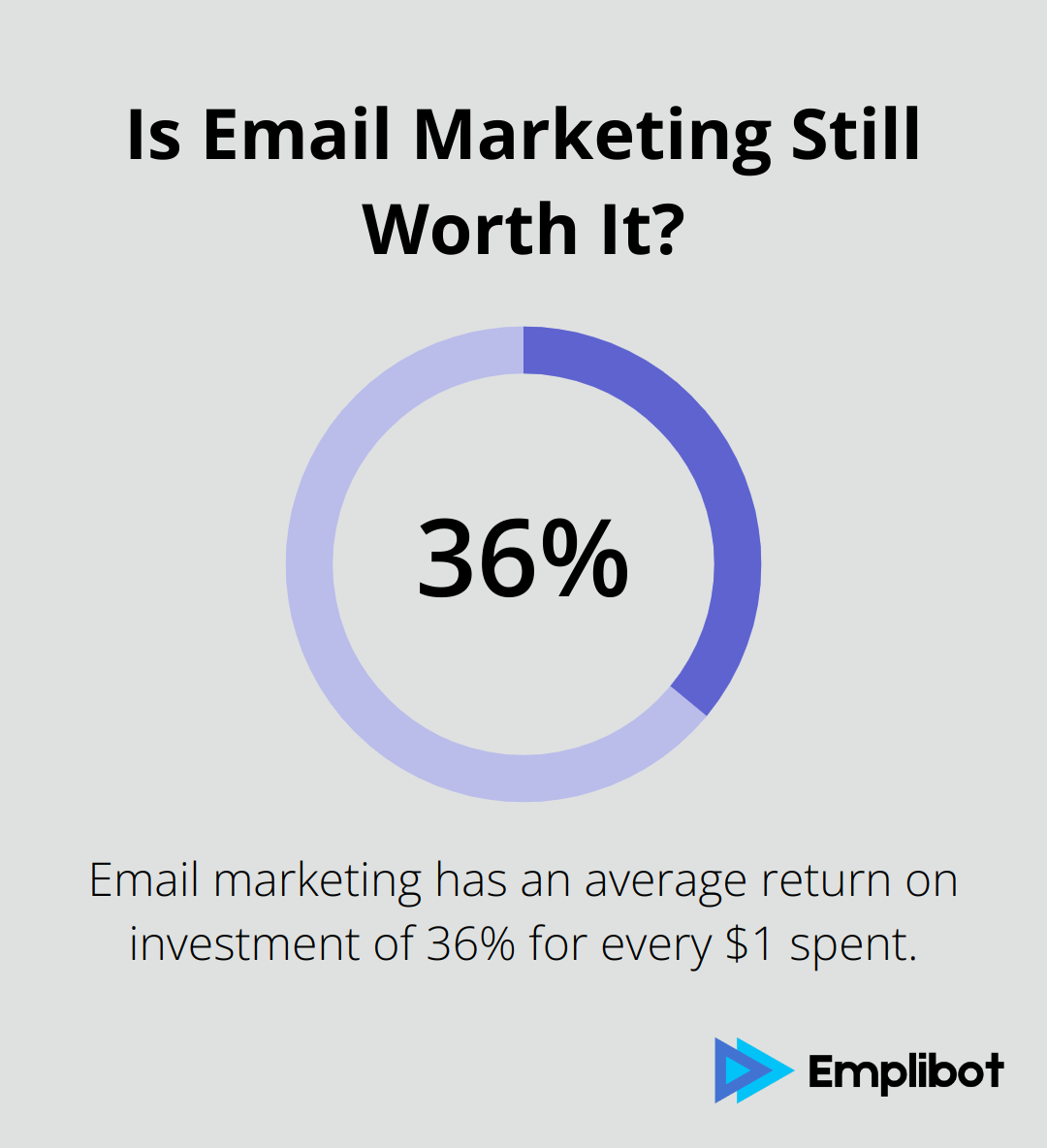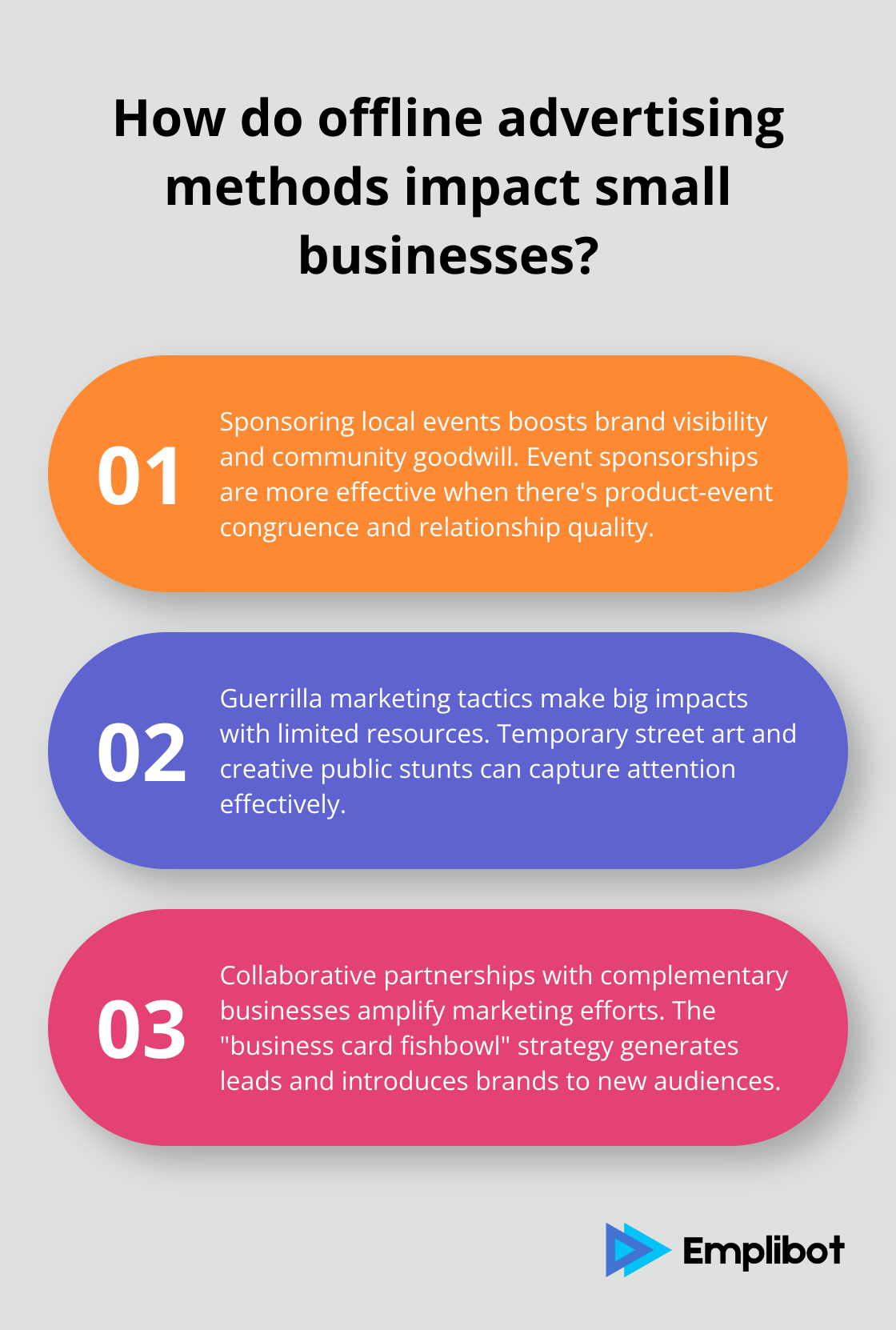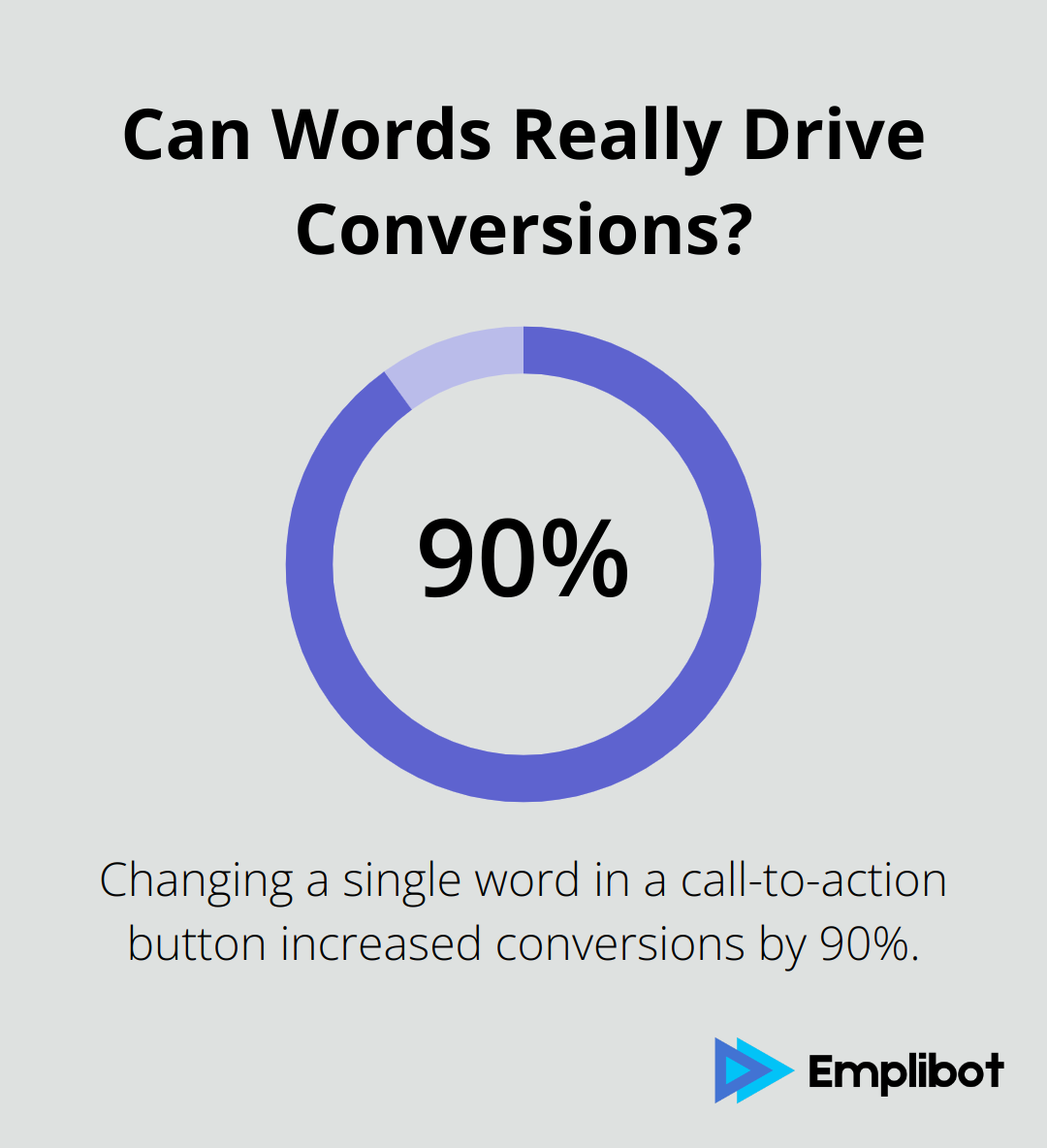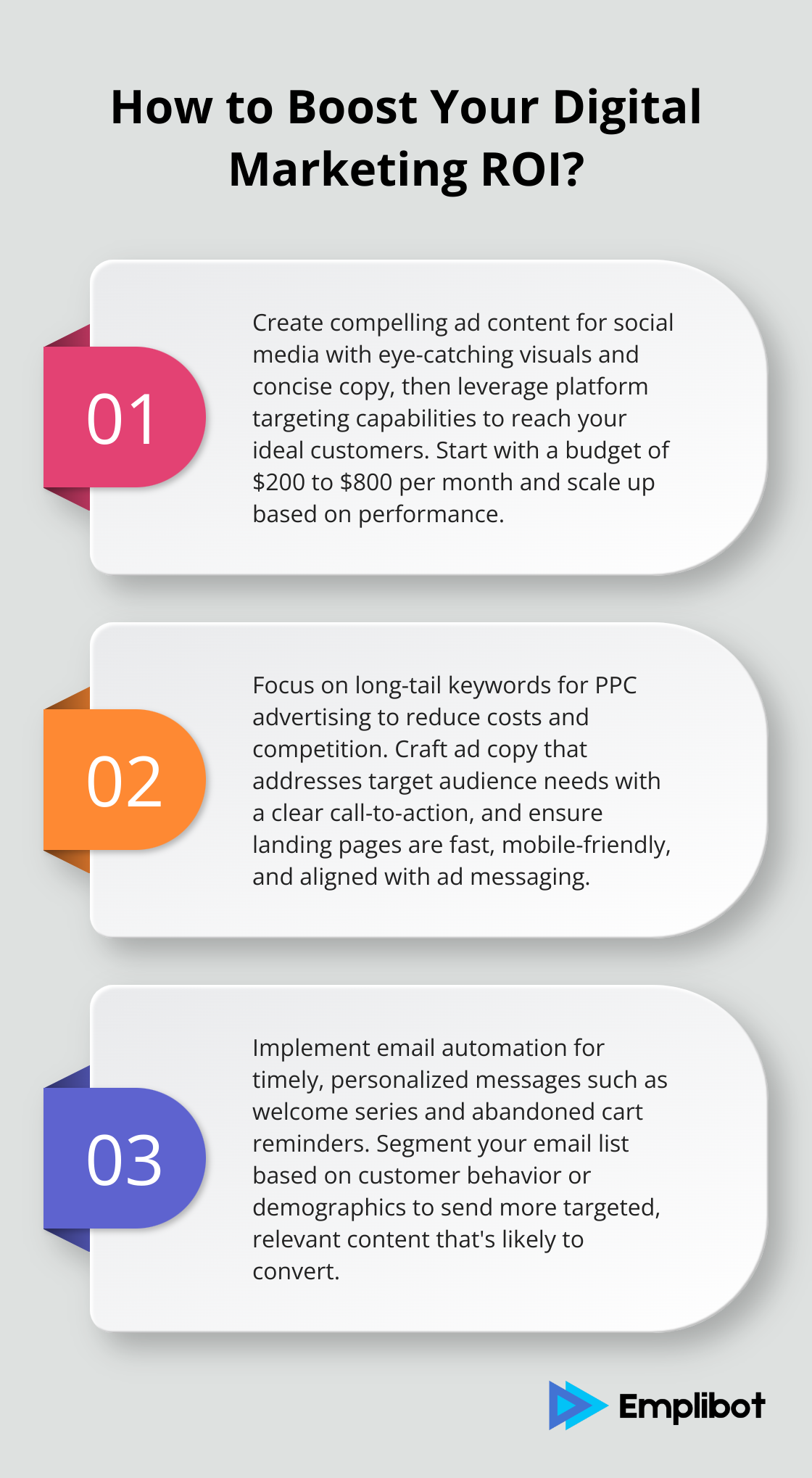Small businesses often struggle to make a big impact with their advertising efforts. At Emplibot, we’ve seen countless entrepreneurs grapple with this challenge.
Effective advertising doesn’t have to break the bank or require a massive team. In this post, we’ll explore practical and innovative advertising ideas that can help small businesses stand out and attract more customers.
Contents
ToggleHow to Maximize Digital Advertising ROI
Digital advertising is a game-changer for small businesses. It’s cost-effective, highly targeted, and offers measurable results. Let’s explore how to make the most of these channels.
Social Media: Your Secret Weapon
Social media platforms are goldmines for small businesses. Facebook, Instagram, and LinkedIn offer powerful advertising tools that allow you to reach your ideal customers with precision.

Start by creating compelling ad content. Use eye-catching visuals and concise, persuasive copy. Remember, you have just seconds to grab attention in a crowded newsfeed.
Next, leverage the platforms’ targeting capabilities. Facebook, for instance, allows you to target users based on demographics, interests, behaviors, and even life events. This level of specificity ensures your ad dollars are spent on reaching the most relevant audience.
Don’t forget to set a realistic budget. Start small, test different ad formats and audiences, and scale up based on what works. According to a report by Hootsuite, businesses spend an average of $200 to $800 per month on social media advertising. This investment can yield significant returns when done right.
Pay-Per-Click: Control Your Spend
Pay-Per-Click (PPC) advertising, particularly Google Ads, is another powerful tool in your digital arsenal. The beauty of PPC is that you only pay when someone clicks on your ad, giving you more control over your advertising spend. Giant retailers can spend up to $50 million per year on paid search in Google Ads.
To succeed with PPC, focus on keyword research. Use tools like Google’s Keyword Planner to find relevant, high-intent keywords that your potential customers are searching for. Long-tail keywords (more specific phrases) often have lower competition and cost less per click.
Craft compelling ad copy that speaks directly to your target audience’s needs and includes a clear call-to-action. A/B test different ad variations to see what resonates best with your audience.
Remember to optimize your landing pages. There’s no point in paying for clicks if your website doesn’t convert visitors into customers. Ensure your landing pages are fast, mobile-friendly, and aligned with your ad messaging.
Email Marketing: Nurture and Convert
Email marketing remains one of the most effective digital advertising channels, with an average return on investment of $36 for every $1 spent, according to Litmus.
Build your email list organically by offering valuable content or incentives in exchange for email addresses. Avoid buying email lists, as this can harm your sender reputation and violate privacy laws.
Segment your email list based on customer behavior, preferences, or demographics. This allows you to send more targeted, relevant messages that are more likely to convert.
Use automation to send timely, personalized emails. Welcome series, abandoned cart reminders, and post-purchase follow-ups can be set up once and continue to drive results over time.
Always provide value in your emails. Mix promotional content with helpful tips, industry insights, or exclusive offers to keep subscribers engaged and looking forward to your messages.
By leveraging these digital advertising channels effectively, small businesses can compete with larger competitors and achieve impressive results. The key is to start small, test consistently, and optimize based on data-driven insights.
How Can Offline Advertising Boost Your Small Business?
While digital advertising dominates the marketing landscape, offline methods still pack a punch for small businesses. These traditional tactics can help you stand out in a crowded market and connect with local customers in meaningful ways.
Sponsoring Local Events
Event sponsorships are a powerful way to increase brand visibility and build community goodwill. Look for events that align with your brand values and target audience. For example, a local bakery might sponsor a charity bake sale, while a sports equipment store could support a youth soccer tournament.

When sponsoring an event, go beyond just writing a check. Offer your products or services as part of the event experience. This hands-on approach allows potential customers to interact with your brand directly. For instance, a coffee shop sponsoring a 5K run could provide free samples at the finish line.
Research suggests that relationship quality and product-event congruence have more influence on increased brand attitude than perceived value in event sponsorships. This underscores the importance of choosing events that align well with your brand and products.
Guerrilla Marketing: Think Outside the Box
Guerrilla marketing tactics can help small businesses make a big impact with limited resources. These unconventional methods rely on creativity and surprise to capture attention.
One effective guerrilla tactic is creating temporary street art. A bookstore could use chalk to create literary quotes on sidewalks leading to their shop. Or a fitness studio might place stickers on elevator buttons encouraging people to take the stairs instead.
Remember, guerrilla marketing should be attention-grabbing but not disruptive or illegal. Always check local regulations before implementing any public marketing stunts.
Collaborative Partnerships
Teaming up with other small businesses can amplify your marketing efforts and expand your reach. Look for businesses that complement yours but don’t directly compete. For example, a pet groomer could partner with a local veterinary clinic to cross-promote services.
One effective collaboration method is the “business card fishbowl” strategy. Place a fishbowl at your partner’s location where customers can drop their business cards for a chance to win a prize from your business. This tactic not only generates leads but also introduces your brand to a new audience.
Through effective collaboration, businesses can pool their resources in marketing, customer acquisition, research, and development, among other areas. This highlights the potential of collaborative marketing for small businesses.
By combining these offline tactics with your digital efforts, you can create a well-rounded marketing strategy that reaches customers across multiple touchpoints. Remember, the key to successful offline advertising is creativity, relevance, and consistency with your overall brand message.
How to Measure and Optimize Your Ad Performance
Effective advertising isn’t just about creating and launching campaigns. It’s about continuously measuring and improving your efforts. At Emplibot, we’ve seen firsthand how proper tracking and optimization can dramatically boost advertising ROI for small businesses.
Identifying Key Performance Indicators
Start by defining clear, measurable goals for your advertising campaigns. These could include website traffic, lead generation, sales, or brand awareness. Then, identify the key performance indicators (KPIs) that align with these goals.

For e-commerce businesses, conversion rate and average order value are crucial KPIs. A study found that the top 500 retailers offering omnichannel services had a median ecommerce conversion rate of 3.73% in 2021, higher than the overall median. If your conversion rate is below average, it’s a clear sign that your ads or landing pages need improvement.
For service-based businesses, lead quality might be more important than quantity. Track metrics like lead-to-customer conversion rate and customer lifetime value. According to HubSpot, the average lead-to-customer rate across industries is about 3.1%, but this can vary widely depending on your sector and pricing model.
Implementing A/B Testing
A/B testing, or split testing, is a powerful way to optimize your ads. This involves creating two versions of an ad with one element changed, then seeing which performs better.
Start with high-impact elements like headlines, images, or call-to-action buttons. For example, when testing email subject lines, MailChimp found that straightforward, descriptive subject lines often outperform “salesy” ones.
Don’t limit A/B testing to your ads. Apply it to your landing pages too. A case study by Unbounce showed that changing a single word in a call-to-action button increased conversions by 90%.
Remember, statistical significance matters. Run your tests for long enough to gather meaningful data. Tools like Optimizely’s Sample Size Calculator can help you determine how long to run your tests.
Leveraging Analytics Tools
Google Analytics is a must-have for tracking website performance. It provides valuable insights into user behavior, traffic sources, and conversion paths. Set up goal tracking to measure specific actions users take on your site, like filling out a contact form or making a purchase.
For social media advertising, each platform offers its own analytics tools. Facebook’s Ads Manager, for instance, provides detailed performance data and audience insights. Use these to understand which ad formats, placements, and targeting options work best for your business.
Consider using heat mapping tools like Hotjar to visualize how users interact with your landing pages. This can reveal usability issues that might be hindering conversions.
Don’t forget about call tracking if phone calls are a significant part of your business. Small to Medium-Sized Businesses (SMBs) rate phone calls as the most valued lead form, according to BIA/Kelsey’s Local Commerce Monitor™.
By consistently measuring your ad performance and making data-driven optimizations, you can significantly improve your advertising ROI. Remember, the key is to start with clear goals, test systematically, and use the right tools to gather and analyze your data. Effective strategies for content marketing can also complement your advertising efforts and contribute to your overall business growth.
Wrapping Up
Effective advertising for small businesses is a dynamic blend of digital prowess and offline ingenuity. We’ve explored a range of strategies that can help your business stand out in a crowded marketplace without breaking the bank.

Digital advertising offers unparalleled targeting capabilities and measurable results. Social media platforms, PPC campaigns, and email marketing provide cost-effective ways to reach your ideal customers. By leveraging these channels strategically, even small businesses can compete with larger competitors and achieve impressive ROI.
However, don’t overlook the power of offline advertising. Sponsoring local events, employing creative guerrilla marketing tactics, and forming collaborative partnerships can help you connect with your community and build lasting relationships with customers. These traditional methods can complement your digital efforts, creating a well-rounded marketing strategy that reaches customers across multiple touchpoints.
The key to successful advertising lies in continuous measurement and optimization. By setting clear goals, identifying relevant KPIs, and consistently testing and refining your approaches, you can maximize the impact of your advertising efforts. Remember, what works for one business may not work for another, so it’s crucial to experiment and adapt your strategies based on your unique audience and objectives.
As you implement these advertising ideas, consider how automation can streamline your marketing efforts. Emplibot offers a comprehensive solution for businesses looking to automate their content marketing and social media strategies, allowing you to focus on other aspects of your business while maintaining a strong online presence.
In the ever-evolving world of advertising, staying agile and open to new ideas is key. Don’t be afraid to try new approaches, learn from your experiences, and continuously refine your strategies. With persistence and creativity, small businesses can create advertising campaigns that resonate with their audience and drive real results.










 Rated Excellent 4.5
Rated Excellent 4.5